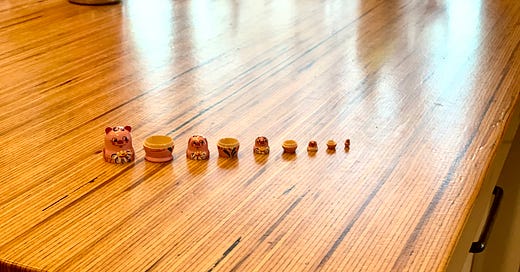This past January I was visiting one of my favorite people and asked her one of my favorite questions: “What’s the one piece of art that has struck you most?” My cousin’s wife, whom I’d asked, said she’d be right back, and a few moments later placed a pig-faced nesting doll, half the size of my thumb, before me. One can’t help but uncouple such a cozy figurine, so I began. The pigs got smaller, and smaller, and as I thought surely a tinier pig could never arrive henceforth—behold, yet a more shrunken pig than before. The final piggy was a true treasure, a third the size of my pinky nail. It was delightful, and everyone drinking wine around me swooned over the marvelous minuscule swine.
We are all susceptible to the wiles of scale. What’s more, we are often transformed by, but undervalue, the power of subtraction.
Conveniently, I just finished reading Subtract by behavioral scientist Leidy Klotz. He argues that as a species we universally suffer from subtraction neglect. When faced with a problem, we too readily offer addition as the solution, when subtracting deserves equal consideration. He says the hurdle to this thinking is our imagination and our dependence on visual representation.
Keep reading with a 7-day free trial
Subscribe to Struck to keep reading this post and get 7 days of free access to the full post archives.




